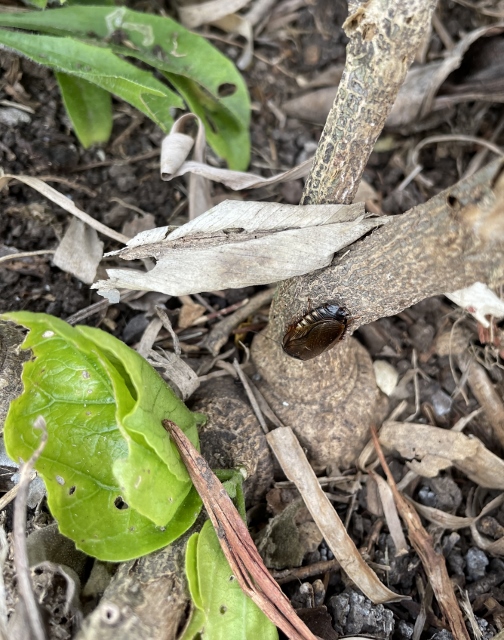
Story and photos by Anita Westervelt, Texas Master Naturalist
I never thought I’d be thrilled to see a cockroach. As I was removing dead branches from emerging growth on a shrub, I disturbed a bug and managed to capture a quick shot with my phone camera. I uploaded the image to an iNaturalist phone app where the bug was quickly identified as a Surinam cockroach.
I’m not generally a fan of cockroaches, rather I was seeing this pest as a member of the food chain — a food source for other critters, like opossums or birds, possibly.
The Valley is still recuperating from the shocking winter weather. Little by little, many plants are showing new leaf growth and blooms. For some plants, it’s a slower process, especially for those plants where upper structure died and the roots are now pushing new growth up from the soil. The plants are alive but the nectar- and pollen- producing flora is behind schedule. Less nectar means smaller numbers of butterflies.
Not only flora has suffered. The insect kingdom also has been affected. In previous years I would be finding myriad caterpillars on vines and other native plants. Normally, in April I’d find leaf-footed bugs on Texas thistle (Cirsium texanum) and basket flower (Plectocephalus americanum) — bugs that are important in the food chain, providing food for birds, spiders, snakes, lizards and frogs.
Insects and bugs serve a number of purposes in nature. Beneficial insects not only pollinate flowers and field crops they also provide meals for other insects, spiders, birds and critters. When insects decline, birds decline.
Butterflies and moths are important in the food chain, too. They lay eggs, the eggs develop into caterpillars; birds consume caterpillars and caterpillars are important in raising young birds. For instance, 90 percent of birds feed their young on caterpillars; they are soft and easily swallowed by nestlings, according to a 2020 Texas Master Naturalist conference lecturer, Doug Tallamy, PhD, University of Delaware entomology and wildlife ecology professor and author of the book, “Nature’s Best Hope — Restoring Nature’s Relationships.”
Caterpillars are a high-protein food source for birds; they are generally easy for birds to find, capture and digest, according to animals.mom.com.

Cockroaches, like the Surinam cockroach, may not be a favored insect, but it is not without benefit. A nocturnal, burrowing cockroach commonly found in loose soil in tropical and subtropical regions, it feeds on plant stems and roots. In turn, toads, frogs and lizards eat cockroaches.
To relieve my mind that the natural world is still in order, I set up a moth sheet and black light apparatus to see what bugs were in my yard overnight. Although not nearly the numbers and variety from last year at this time, I was encouraged to find a variety of insects and some old friends, like geometer, graphic, owlet and tussock moths — more moths, more potential caterpillars.

The annual City Nature Challenge is taking place through Monday. Consider participating even if only documenting what you find in your own yard or neighborhood. Visit www.iNaturalist.org for how to participate.

